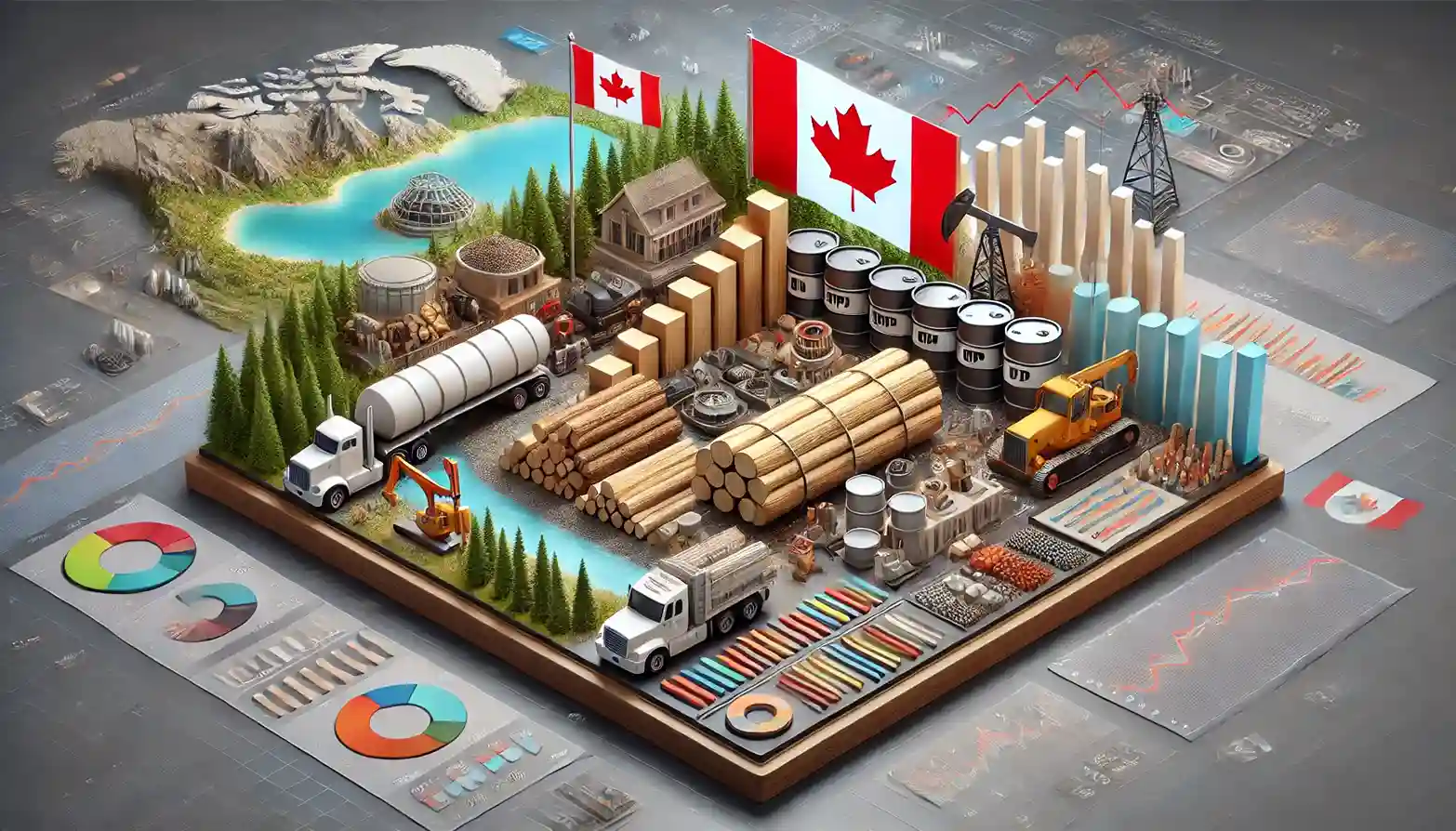In the fast-paced world of forex trading, keeping an eye on economic indicators is crucial. One such indicator that often flies under the radar but can significantly impact forex markets is the Canadian Raw Materials Price Index (RMPI). This article will take a deep dive into the RMPI, its relevance to forex trading, and how traders can use this information to their advantage.

Canadian Raw Materials Price Index
The Canadian Raw Materials Price Index, commonly referred to as RMPI, is a measure of the price change for raw materials purchased by Canadian manufacturers. It includes commodities like crude oil, metals, and agricultural products. But why should forex traders care about this index?
Understanding the Basics of RMPI
Before we delve into the forex implications, let’s understand what RMPI actually represents. It’s essentially a reflection of the prices that manufacturers pay for their raw materials. This index is a critical component in understanding the cost structure of Canadian production and can influence inflation and overall economic health.
What Does RMPI Measure?
RMPI measures the changes in the cost of raw materials over time. It includes a broad range of commodities, making it a comprehensive indicator of the raw material cost pressures faced by manufacturers. The index is vital for assessing inflationary trends within the economy.
Components of RMPI
The RMPI is made up of various components, each with its own weight. Crude oil typically holds a significant portion, reflecting its importance in manufacturing and transportation. Metals, like aluminum and copper, and agricultural products, such as wheat and corn, are also included.
The Importance of RMPI in the Canadian Economy

Now, why does RMPI matter so much for the Canadian economy? Canada is a country rich in natural resources, and the prices of these resources can have a profound impact on its economic performance. High raw material costs can lead to increased production costs, affecting everything from manufacturing to consumer prices.
Inflation Indicator
The RMPI is a leading indicator of inflation. When the prices of raw materials rise, manufacturers may pass these costs onto consumers, leading to higher consumer price inflation. This can trigger a response from the Bank of Canada in terms of monetary policy adjustments.
Impact on GDP
A rise in raw material prices can affect Canada’s Gross Domestic Product (GDP). Higher costs might reduce the competitiveness of Canadian goods on the international market, potentially leading to lower exports and, consequently, a negative impact on GDP growth.
How RMPI Influences Forex Markets
Now that we have a grasp of what RMPI is and its importance, let’s connect the dots to forex trading. Forex markets are highly sensitive to economic indicators, and RMPI is no exception.
Currency Value Fluctuations
The value of the Canadian dollar (CAD) can be influenced by changes in the RMPI. When raw material prices increase, it can signal economic growth, potentially strengthening the CAD. Conversely, a drop in raw material prices might weaken the CAD as it could indicate economic slowdowns.
Market Sentiment
Forex traders pay close attention to RMPI releases. Positive RMPI data can lead to bullish sentiment for the CAD, while negative data might cause bearish trends. Traders often position themselves ahead of RMPI releases, speculating on the outcome.
Strategies for Forex Traders Using RMPI

So, how can forex traders leverage RMPI data to make informed trading decisions? Here are some strategies to consider.
Monitoring RMPI Releases
Keep a close eye on the calendar for RMPI releases. These are typically published monthly by Statistics Canada. Understanding the historical data and trends can help traders anticipate market reactions.
Analyzing Correlations
Look for correlations between RMPI data and CAD movements. For instance, if there’s a consistent pattern where a rise in RMPI leads to a stronger CAD, traders can use this information to their advantage.
Case Study: RMPI and the Canadian Dollar
To illustrate the impact of RMPI on forex markets, let’s look at a case study. In early 2020, RMPI data showed a significant drop due to falling crude oil prices. This decline correlated with a weakening of the CAD against major currencies.
Impact of Crude Oil Prices
Since crude oil is a major component of the RMPI, its price movements can heavily influence the index. In our case study, the fall in crude oil prices not only impacted RMPI but also had a cascading effect on the CAD, highlighting the interconnectedness of these elements.
Trader Reactions
Forex traders who anticipated the drop in RMPI due to falling oil prices positioned themselves accordingly, selling the CAD. Those who were aware of the RMPI data beforehand managed to capitalize on the market movement.
Tips for Using RMPI in Forex Trading

Leveraging RMPI data effectively requires a nuanced approach. Here are some practical tips for forex traders.
Stay Informed
Regularly check RMPI data releases and economic calendars. Being informed allows traders to anticipate potential market movements and adjust their strategies accordingly.
Combine with Other Indicators
While RMPI is important, it should not be used in isolation. Combine it with other economic indicators like the Consumer Price Index (CPI) and Gross Domestic Product (GDP) for a more comprehensive analysis.
Common Mistakes to Avoid
Even experienced traders can make mistakes when using RMPI data. Here are some common pitfalls to watch out for.
Overreliance on RMPI
Relying solely on RMPI data can be risky. Market conditions are influenced by a multitude of factors, and ignoring other indicators or geopolitical events can lead to poor trading decisions.
Ignoring Context
Always consider the broader economic context. For example, a rise in RMPI might be due to temporary supply chain disruptions rather than a long-term trend. Understanding the reasons behind RMPI movements is crucial.
RMPI in Global Context

Canada is not the only country that tracks raw material prices. Comparing RMPI with similar indices from other countries can provide additional insights.
Global Commodities Market
The global commodities market plays a significant role in shaping RMPI. Price movements in international markets, such as oil and metals, can directly impact the Canadian index and, by extension, the CAD.
International Trade Relations
Canada’s trade relations with other countries also influence RMPI. Changes in trade policies, tariffs, and international demand for Canadian raw materials can affect the index and forex markets.
Future Trends and RMPI
Looking ahead, several trends could influence RMPI and its relevance to forex trading. Staying ahead of these trends can give traders an edge.
Sustainable Practices
As the world shifts towards more sustainable practices, the demand for certain raw materials may change. This could impact RMPI components and, consequently, the forex market.
Technological Advancements

Technological advancements in extraction and production can also influence raw material prices. Keeping an eye on these developments can help traders anticipate changes in RMPI and market reactions.
Conclusion
The Canadian Raw Materials Price Index is a vital economic indicator with significant implications for forex trading. By understanding RMPI, its components, and its impact on the Canadian economy, traders can make more informed decisions. Leveraging RMPI data, along with other economic indicators, can provide a strategic edge in the dynamic world of forex trading. Remember, while RMPI is crucial, always consider the broader economic context and stay informed about global trends to navigate the forex market successfully.
FAQs
1. What is the Canadian Raw Materials Price Index (RMPI)?
The RMPI measures the price changes of raw materials purchased by Canadian manufacturers, including commodities like crude oil, metals, and agricultural products.
2. How does RMPI affect the Canadian dollar (CAD)?
Changes in RMPI can influence the value of the CAD. An increase in raw material prices might strengthen the CAD, while a decrease can weaken it.
3. Why is RMPI important for forex traders?
Forex traders monitor RMPI as it provides insights into inflationary pressures and economic health, influencing trading decisions related to the CAD.
4. Can RMPI be used in isolation for trading decisions?
No, RMPI should be combined with other economic indicators like CPI and GDP for a comprehensive analysis of market conditions.
5. How often is RMPI data released?
RMPI data is typically released monthly by Statistics Canada, providing regular updates on the price changes of raw materials.
